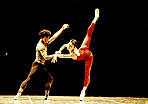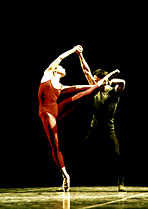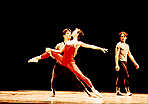
|
|
Mar. 25, 1997
|
Art Watch Index - Mar. 18, 1997
![]()
|
"Steptext" (choreographed by William Forsythe)

"Steptext"
Forsythe http://www.ntticc.or.jp/ workshop/forsythe/ index_e.html
Paris Opera Ballet
|
"'Pretending'
It is probably not a mistake to say that when comparing a "stiff" and a "supple" dance, the latter is better, but one comes to remember that there is a troublesome syndrome of "pretending to be supple". The recent groove scene As for myself, I was able to say before that "the artistic dance lacks groove, and that they should study the reruns of 'Soul Train' or Forsythe", but today, the Tokyo contemporary dance scene is filled with the "pseudo-Forsythe's". However, if asked whether they have all become "supple", it is difficult to say. For example, this is the same as the "groove issue" (so named by myself) in music. In the music software for computers, there is a function which creates "groove". Even when one inputs a drum pattern in the normal rhythm, with a click, he can choose various ways to "syncopate". Today, everyone talks about "groove", but maybe that means a "pretended groove = suppleness" like the fuzzy function (handicraft that is sampled and analyzed) of the software. Coming back to the subject of dance, today everyone talks about Forsythe, but that points to a convenient function (various "Forsythe-like" vocabulary = collection of samples) for creating "cool dance", which means that if one uses that, the result would be a "pretended suppleness". Literally, this means wearing toe shoes and moving flaccidly like an octopus. As long as one does this, a good-natured critic will say things like "an organ-less body" or "de-centralization", or even "sampling taken from ballet that is edited->remixed". However, this is being too "predictable". The <strength> called weight The Star Dancers Ballet were the first to perform a Forsythe work as a Japanese company. Their performance looked quite different from what is called a "pseudo-Forsythe" or a "Forsythe-like" dance often imagined by people. The biggest difference was that they looked "heavy". It is true that the chosen work was an early Forsythe dance (1984) where the expected "flaccidity" had not appeared yet, and "outwardly", it looked very much like ballet. However, this work was the starting point of a "totally new dance language created by deconstructing ballet" which is often mentioned today. In other words, here the "stiffness" = "tenseness" of ballet as a system is the issue. As indicated in the description of ballet, that it is an art of "lightness" or "balance", the "lightness" may be a fabrication created from "balance". In order to expose this, Forsythe brings the ballet-like dance to the limit. In other words, he simply creates an ultra-difficult "ballet". Then, the "ballet" is confronted with resistance from gravity and the body. The performance carrying a heaviness executed by the stiffness, the delay, and the body of the Star Dancers indicated this fact correctly, and it can be said that this made the exceptional <strength> possible. "Stiffness" and "hardness" When it comes to the Forsythe performed by the Paris Opera Ballet Company (the zenith of the ballet world!), their "disciplined" ballet-like bodies "pretend" to maintain even more balance. To do so, they secretly add movements that are not included in the choreography. That is the preparatory movement called "preparation", but at the same time, that is merely the court dance which is the origin of ballet, and furthermore, that is the "flirtatiousness" = "pretension of suppleness, elegance" of the court people which is the origin of the court dance. By the way, the children of the "pseudo-Forsythe" dance, who try to stay aloof by rejecting ballet, are just showing that they can destroy the balance in places where they can maintain balance. They are merely trying to show off and "look cool". Should we intentionally express the Forsythe performed by the Star Dancers as being "stiff" compared to the "pretended suppless" of such ideology (as that of the 19th century?) and rhetoric (post-modern?)? The answer to the question may be obvious, but we must mention that they are "stiff" in a different meaning. Their "bodies" are stiff, or rather, "hard". [Keisuke SAKURAI/Musician]
|
|
|
|
"Last Man Standing"
Bruce Willis MOVIEWEB: Last Man Standing http://movieweb.com/ movie/lastman/index.html
Last Man Standing -- CINEMA ONE
Last Man Standing (1996/I)
Akira Kurosawa Database
Filmography for Akira Kurosawa
Akira Kurosawa (in Japanese)
Yojimbo(1961)
Citizen Kane(1941)
Filmography for Preston Sturges
Apocalypse Now Tribute page
Apocalypse Now (1979)
Filmography for Orson Welles
Pretty Woman (1990)
Filmography for Jean-Luc Godard
Filmography for Bruce Willis
Filmography of John Ford (I)
The Unofficial Desperado/El Mariachi Home Page
Desperado (1995)
Ying Huang Boon Sik (1986)
Good Fellows, The (1943)
Casino (1995)
|
"Last Man Standing"
Films could not exist without remakes For some reason, there is a thing called "remake" for movies. For example, Walter Hill's "Last Man Standing" is a remake of Akira KUROSAWA's "Yojimbo". Besides this, there is "Citizen Kane", which is said to be the remake of Preston Sturges's film, "Apocalypse Now", which is said to be the film conceived by Orson Wells, and "Pretty Woman", which is also said to be the remake of another movie. Films which have already materialized are regenerated in another form, and the vestiges of imagination which were not established in the previous film coagulate as if reminded and incited by the trends of the age. These (revived films) have stimulated, and sometimes have not stimulated, the desires of the people. In terms of remake films, in the past ten years, although attempts were made towards evaluations for the films to be more than just revivals, they are nothing new as a phenomenon, and the existence of movies themselves was only possible with the presence of remakes. Historical / historical behavior which is conscious of being historical It is not that the movie was a repetition of imitation and plagiarism driven by greed, from the time of inception. As seen in the "artistic films" in France and the biographical movies from Warner Bros., the film itself, which was trying to gain citizenship, was already a remake of something. When the original was a novel, it was just that a genre of questionable origin tried to gain authority by building on another questionable genre that was a little older than the former. Certainly, dramatization and remake are different. However, because it is true that making a film based on another movie forces the film to become historical, just from the fact that it is conscious of the existence of the precedent movie, a remake is not only historical in terms of being chronological, but it also behaves historically because it is aware that it must be "historical". In the times when the studio system flourished, producers made remake films freely, but that was because they did not need to be conscious of history. Such a behavior was not allowed for Jean-Luc Godard, who knew that movies had history. This is clear if one thinks of his early films, which were devoted to monogram or to the films from companies that took the initiative in doing remakes and sometimes even films bordering on plagiarism. Remake - a reiteration that is possible because of the difference between the repetitions What type of remake would "Last Man Standing", which is a remake of "Yojimbo", be? Bruce Willis, who stops by the town of Jericho, sees a horse's carcass covered with flies -- a typical Sam Peckinpah-like object. On the other hand, one may be reminded of Peckinpah by seeing a scene in which a Mexican army fires a fusillade of bullets towards a gang inside a train car, or he may remember John Ford by seeing Willis sit down with his legs propped on a fence. However, this film is not a movie by Peckinpah nor John Ford; it is only a contemporary film borrowing the setting from "Yojimbo". It is clear that this movie, "Last Man Standing", which connects with "Desperado" and "A Better Tomorrow" in terms of the number of bullets consumed, and relates to "Good Fellows" and "Casino" in terms of the volume of the monologue-type narration, is less than that of Akira KUROSAWA's for its visual story-telling; but considering that Akira KUROSAWA started to shoot films after the invention of the talkie, this film should be described as a regressive contemporary film rather than a modern film. If the "remake" were just a repetition reiterating the setting of a "masterpiece", there is no need for it to be a movie. However, it may mean that it shows how much more difficult it is to grasp the fact that a reiteration should not be merely a repetition of the same thing, but is called a "reiteration" because the repeated things are "different". [Yuzo MORITA/Film Critic]
|
|
|
|
|
|
|
|
|
Mar. 25, 1997
|
[home]/[Art Information]/[Column]
Copyright (c) Dai Nippon Printing Co., Ltd. 1997
Network Museum & Magazine Project / nmp@nt.cio.dnp.co.jp


 Preview
Preview



